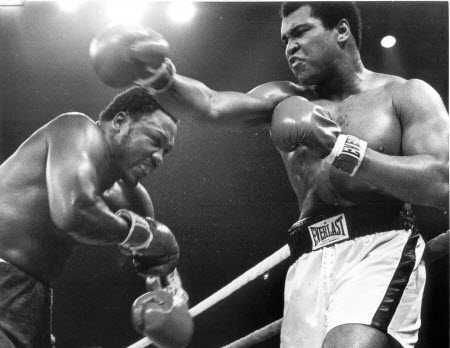The Fight That Helped Cable Take Flight

Forty years ago, a group of industry pioneers gathered in Vero Beach, Fla., to take part in cable programming’s version of Kitty Hawk.
It was Sept. 30, 1975, and the industry leaders, flanked by a 10-meter satellite dish and nattily dressed in 1970sstyle suits, oversaw the live satellite telecast of the Muhammad Ali-Joe Frazier “Thrilla in Manila” boxing match on HBO. The launch of HBO on satellite is regarded as the birth of the modern cable industry.
“It was a tremendous surge of pride in the industry to be able to bring that into homes,” Jerry Levin, then president of HBO, said in an interview.
“It’s a reminder that a band of relatively small entrepreneurs were able to change the face of American video,” Levin said. “Going up on the satellite was really the impetus for all the programming we see today.”
In addition to boosting the fortunes of HBO, the next five years saw the satellite launch of major cable network brands, including CNN, TBS, ESPN, MTV, BET, Nickelodeon, Showtime, USA Network, WGN, Bravo, CBN (now ABC Family) and C-SPAN.
Satellite pioneer Sid Topol, who supplied dishes for the HBO telecast while chairman and CEO of Scientific-Atlanta, recalled in an interview: “It was a money maker for everyone from day one, including me. I couldn’t build earth stations fast enough.
“HBO took off, and the cable systems became viable and could franchise in the big cities. Before that, it didn’t work,” he said.
Multichannel Newsletter
The smarter way to stay on top of the multichannel video marketplace. Sign up below.
Before satellite delivery, cable programming had to be delivered to systems by terrestrial microwave technology or by “bicycling” videotape — that is, delivering it by hand. Reaching a mass audience was nearly impossible.
In 1972, Levin worked with Chuck Dolan at Sterling Manhattan Cable to develop a pay TV service that he named Home Box Office. Time Inc. took full ownership of HBO, but soon threatened to shut down the unprofitable enterprise, according to Levin, who tried anything to increase subscribers, including giving away free turkeys.
Meanwhile, Topol, who had experience with international satellites, promoted domestic satellite delivery of programming. Cable operators such as Bob Rosencrans, president of UA-Columbia Cablevision, were looking for more content to make cable more viable with consumers.
During an National Cable Television Association convention in Anaheim, Calif., in 1973, S-A demonstrated satellite capability, including a live broadcast with House Speaker Carl Albert. HBO arranged for a live satellite telecast of a boxing match beamed from Madison Square Garden to the Disneyland Hotel.
But the fight ended with a first-round knockout, so quick that even Levin missed it. The demo was met largely with concern about potential satellite failures and a cost of about $100,000 to install a 10-meter earth station.
Topol said he kept getting asked, “Where are the programs going to come from?”
Nonetheless, Levin remained intrigued and Topol continued to promote satellite’s benefits. The Ali-Frazier fight in Manila — the third of their famous bouts — presented a new opportunity to use satellite distribution for cable.
In those days, boxing made significant money through closed-circuit broadcasts in movie theaters. HBO was allowed to deliver Ali-Frazier via a Westar satellite only to two cable operators: UA-Columbia in Ft Pierce-Vero Beach, Fla., and a Jackson, Miss., system owned by ATC, founded by Monty Rifkin.
First, the systems had to get FCC permission to erect satellite receive-only dishes. Cable had competing interests that could object, including movie studios and broadcasters, but none did. The FCC, however, was concerned about technical interference, according to The Cable Center’s archives.
Transmissions from Manila had to take a series of hops around the world to get to Vero Beach. There, in a Holiday Inn ballroom, Rosencrans flipped a switch to start the telecast of the fight, which Ali won by technical knockout after 14 rounds.
“When you looked at the close-ups, the fighters looked like they were in the next room, the picture quality was that extraordinary,” Rosencrans said in an interview for Columbia University. “We knew we had a winner. We knew this was a big day.”
In December 1975, RCA launched a Satcom satellite bird 23,300 miles into orbit, and HBO leased transponder space. The next year, the FCC approved smaller, more affordable 4.5-meter receive- only dishes for cable systems.
Topol talked to an ambitious Ted Turner, who turned WTBS-TV, a small Atlanta TV station, into the first nationwide superstation in 1976 and launched CNN in 1980. After the first wave of satellite network launches, a second wave from 1980 to 1985 included Discovery Channel, Disney Channel, A&E Network, AMC, HSN, Headline News, Lifetime and The Weather Channel.
“There would be no Golden Age of Programming today if there hadn’t been this proliferation of networks,” said Levin, who served as chairman and CEO of Time Warner, Inc. from 1993 to 2002.
Satellite also produced cable’s biggest competitors through the mid-’90s launch of DirecTV and Dish Network.
Today, Levin, 76, recently founded The Levin Center for Parkinson’s Transformational Health; Topol, 90, is active in political causes in Boston; and Rosencrans, 88, lives in Greenwich, Conn. All are Cable Hall of Fame members.
Craig Leddy is a student of cable history who teaches How Cable Works courses.
